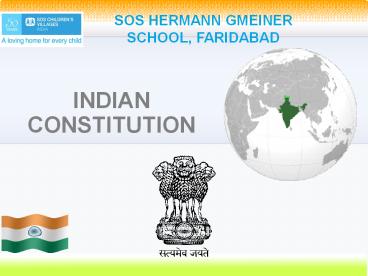top school in Faridabad |best school in Faridabad | - PowerPoint PPT Presentation
Title:
top school in Faridabad |best school in Faridabad |
Description:
top school in Faridabad |best school in Faridabad |Best CBSE school in Faridabad |Top CBSE school in Faridabad | Hermann Gmeiner School Faridabad was established in 1986 by the SOS children's Villages Organization based in Austria. The school is situated in beautiful green environs in Sector 29, Faridabad in an expanse of 6.5 acres of pollution free land. The school campus is designed by German Architect. The building has a unique structure with well-planned class rooms and play grounds. Since its foundation in 1986, the school has grown from strength creating a niche for itself as a premier educational institution. A play way method of interaction initiates children into the wonderful New World of Education. Their enthusiasm, creativity and expression are given free space and environment. top school in Faridabad |best school in Faridabad |Best CBSE school in Faridabad |Top CBSE school in Faridabad – PowerPoint PPT presentation
Number of Views:68
Learn more at:
http://www.hgsfaridabad.org/
Title: top school in Faridabad |best school in Faridabad |
1
SOS HERMANN GMEINER SCHOOL, FARIDABAD
INDIAN CONSTITUTION
2
CONTENTS
2
3
1.What Is Constitution Anyway?
Almost everything we do is governed by some set
of rules. There are rules for games (like-
soccer), for social clubs and for adults in the
workplace. There are also rules imposed by
morality and custom that play an important role
in telling us what we should and should not do.
For example- In the game of soccer, a referee has
"full authority to enforce the Rules or Law of
the Game on the Players, when a player do
something against the Rules referee takes action
like send-off a player, as shown in images below.
3
4
2.Why Do We Need Constitution?
- In General-
- We need a constitution to govern a country
properly. - The constitution defines the nature of political
system of a country. - sometimes we feel strongly about an issue that
might go against our larger interests and the
constitution helps us guard against this. - All the 3 organs of government (executive,
legislature and judiciary) functions within the
constitution. All the 3 organs of government,
including ordinary citizens, derive their power
and authority (i.e. Fundamental Right) from the
constitution. If they act against it, it is
unconstitutional and unlawful. - So constitution is required to have authoritative
allocation of power and function, and also to
restrict them within its limit.
4
5
3.The History of Constitution of India.
5
6
4.The Framing of Constitution of India.
Dr. Sachchidananda Sinha was the first president
(temporary) of the Constituent Assembly when it
met on December 9, 1946. Later, Dr. Rajendra
Prasad became the President of the Constituent
Assembly and Dr. Bhimrao Ambedkar became the
Chairman of its drafting committee on December
11,1946 .
6
7
5.The Preamble to Constitution of India.
- The first words of the Preamble - "We, the
people" - signifies that power is ultimately
vested in the hands of the People of India. So
far the Preamble has been amended only once in
1976 by 42nd amendment (change) which inserted
the words Socialism, Secularism and Integrity. A
brief description of these concepts are as
follows (in the order they come in Preamble)- - Sovereign- It means free to follow internal and
external Policies. - Secular- It means no particular Religion is
preferred. - Socialist- It means no concentration of Power and
Money. - Democratic- It means rule by elected
representative of the People of India. - Republic- It means no room for hereditary ruler
or monarch.
7
8
6.What Is The constitution of India?
8
9
7.Main Characteristics of Constitution of India.
- The Constitution of India has some distinct and
unique features as compared to other
constitutions to the world. As Dr. B.R. Ambedkar,
the Chairman of the Drafting Committee puts it,
the framers had tried to accumulate and
accommodate the best features of other
constitutions, keeping in view the peculiar
problems and needs of our country. Main
Characteristics of Constitution of India are- - Longest written constitution.
- Partly Rigid and Partly Flexible
- A Democratic Republic
- Parliamentary System of Government
- A Federation
- Fundamental Rights
- Directive Principles of State Policy
- Fundamental Duties
- Secular State
- An Independent Judiciary
- Single Citizenship
9
10
8.Conclusion
A Constitution symbolizes independence of a
country. Framework and structure for the
governance of a free country are provided in the
Constitution. The Constituent Assembly prepared
the draft of the Constitution by keeping the
Objectives Resolution as the backdrop which
reflected the aspirations of the people of
India. The framing of the Constitution was
completed on November 26, 1949 when the
Constituent Assembly formally adopted the new
Constitution. The Constitution came into force
with effect from January 26, 1950. The
Constitution begins with a Preamble which
declares India to be a Sovereign, Socialist,
Secular, Democratic, Republic. The Preamble also
mentions the goals of securing justice, liberty
and equality for all its citizens and promotion
of natio-nal unity and integrity on the basis of
fraternity among the people assuring dignity of
the individual.
10































